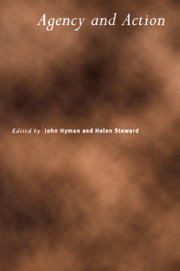Book contents
- Frontmatter
- Contents
- Preface
- Notes on Contributors
- Agency and Actions
- Two Ways of Explaining Actions
- Anscombe on ‘Practical Knowledge’
- Action, the Act Requirement and Criminal Liability
- Emotion, Cognition and Action
- Kantian Autonomy
- The Structure of Orthonomy
- Normativity and the Will
- Can Libertarians Make Promises?
- Intention as Faith
- The Destruction of the World Trade Center and the Law on Event-identity
The Destruction of the World Trade Center and the Law on Event-identity
Published online by Cambridge University Press: 07 September 2010
- Frontmatter
- Contents
- Preface
- Notes on Contributors
- Agency and Actions
- Two Ways of Explaining Actions
- Anscombe on ‘Practical Knowledge’
- Action, the Act Requirement and Criminal Liability
- Emotion, Cognition and Action
- Kantian Autonomy
- The Structure of Orthonomy
- Normativity and the Will
- Can Libertarians Make Promises?
- Intention as Faith
- The Destruction of the World Trade Center and the Law on Event-identity
Summary
Introduction
September 11, 2001 brought to legal awareness an issue that has long puzzled metaphysicians. The general issue is that of eventidentity, drawing the boundaries of events so that we can tell when there is one event and when there are two. The September 11th version of that issue is: how many occurrences of insured events were there on September 11, 2001 in New York? Was the collapse of the two World Trade Center Towers one event, despite the two separate airliners crashing into each tower? Or were these two separate insured events?
Usually such puzzles are the stuff of academic debate amongst professional philosophers specializing in the metaphysics of event identity. Metaphysics is an arcane speciality carried on by ‘those happy few who feel the intellectual fascination in … grubbing around in the roots of being.’ The metaphysics of events is a specialty within metaphysics, capturing the attention of many professional philosophers in the 1970s, but otherwise remaining esoteric even within the confines of professional philosophy. Now such an issue has emerged from the academic shadows into the bright light of a 3−½ billion dollar legal controversy. For the owners of the World Trade Center lease, the Silverstein group, had obtained casualty (‘first party’) insurance for property damage with a limit of approximately 3−½ billion dollars ‘per occurrence.’ The question in the current lawsuits between those owners and the insurance companies, is whether there was one such occurrence or two when al Qaeda terrorists destroyed the World Trade Center. Such questions of individuation have often been scorned as pejoratively academic questions—like asking how many angels can dance on the head of a pin—but now the financing of the rebuilding of a major American monument turns on the question.
- Type
- Chapter
- Information
- Agency and Action , pp. 259 - 342Publisher: Cambridge University PressPrint publication year: 2004
- 1
- Cited by



